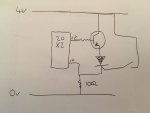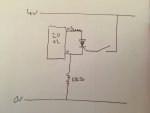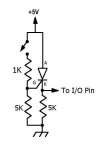Jamiestyles
New Member
I am using a Thyristor to monitor an input. When the input goes high the thyristor goes on and the Picaxe increases the variable. I can't use an interrupt because most of the program is using COUNT and it doesn't register the momentary high of the switch during the COUNT function.
I obviously need to reset the Thyristor after the variable has been increased and I have been using a Transistor to cut the current to reset it.
I've been using the following circuit for a while and it works fine and reliably although I am aware it is probably not best practice. Its current draw is also quite high:

To save on components would this work or is it really bad practice?

What is the best way to reset a thyristor using a Picaxe?
Many thanks in advance for your help.
I obviously need to reset the Thyristor after the variable has been increased and I have been using a Transistor to cut the current to reset it.
I've been using the following circuit for a while and it works fine and reliably although I am aware it is probably not best practice. Its current draw is also quite high:

To save on components would this work or is it really bad practice?

What is the best way to reset a thyristor using a Picaxe?
Many thanks in advance for your help.

